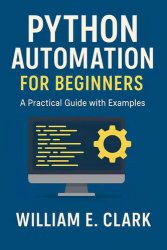Python Automation for Beginners: A Practical Guide with Examples
- Добавил: literator
- Дата: 1-04-2025, 03:00
- Комментариев: 0
 Название: Python Automation for Beginners: A Practical Guide with Examples
Название: Python Automation for Beginners: A Practical Guide with ExamplesАвтор: William E. Clark
Издательство: Nobtrex L.L.C.
Год: 2025
Страниц: 317
Язык: английский
Формат: epub (true)
Размер: 10.1 MB
This book offers a comprehensive introduction to Python programming and automation, designed specifically for individuals with little to no prior coding experience. It provides detailed, methodical instruction that combines foundational concepts with practical applications, allowing readers to build technical proficiency from the ground up.
Through a structured progression of topics, the text covers installing and configuring Python, understanding basic syntax, and developing control flow strategies using conditionals and loops. The book further explores the creation of modular code through functions and modules, manages file and directory operations, and demonstrates how to integrate external libraries to enhance automation capabilities.
Automation in Python frequently depends on external libraries that extend the functionality provided by the standard library. These libraries are developed and maintained by a community of programmers and serve specific automated tasks which range from interacting with web pages to processing and analyzing data. The targeted libraries increase the flexibility, efficiency, and power of Python scripts, enabling developers to perform operations that would be laborious if written from scratch.
One of the critical areas where external libraries excel is in web automation. Python libraries such as requests, BeautifulSoup, and Selenium have become indispensable tools for automating interactions with web resources. The Requests library simplifies the process of sending HTTP requests and handling responses, handling common tasks such as interacting with RESTful interfaces. BeautifulSoup is used for parsing HTML and XML documents, enabling automated scripts to extract and manipulate web data. Furthermore, Selenium serves a different purpose by providing an interface for automated web browser control. It simulates user actions such as clicks and form submissions, which is particularly useful for testing web applications and performing browser-based automations.
Beyond web automation, tasks involving data manipulation are equally important in automation workflows. Libraries such as pandas and the built-in json module offer powerful capabilities in data handling. pandas provides extensive functions for reading, cleaning, and analyzing data, using data structures like DataFrames that simplify complex data operations. Scripts that automate data collection, transformation, and reporting often incorporate pandas for its efficiency in handling tabular data. The json module, on the other hand, is integral for parsing JSON formatted data, a common data interchange format in web applications. Together, these libraries allow a developer to streamline operations such as data extraction from various sources, transformation of raw data into structured formats, and its subsequent analysis.
Network operations represent another domain where external libraries significantly enhance Python’s automation capabilities. Libraries such as Paramiko provide capabilities for automating secure shell (SSH) connections, file transfers, and remote command execution over SSH. This is critical for tasks such as server administration, automated backup procedures, and remote software deployment. Furthermore, the built-in sockets library enables communication between programs over networks, allowing the development of custom client-server automation solutions. This library provides lower level network communication facilities, which can also be augmented with higher level libraries for specific protocols and tasks.
Desktop and graphical user interface (GUI) automation is supported by libraries such as PyAutoGUI. This library automates interactions with the operating system’s GUI, including controlling the mouse and keyboard to simulate user inputs. It enables automation of repetitive tasks on desktop applications that do not have readily available APIs. By capturing screen information and simulating clicks or keystrokes, PyAutoGUI extends Python scripts into areas that traditionally require manual operation. Automation of GUI tasks can drastically reduce human error and improve workflow consistency in applications that are inherently interactive.
Readers will benefit from clear explanations, real-world examples, and step-by-step guidance aimed at developing robust, maintainable code. This treatment of essential programming concepts, error handling, and practical project implementation equips newcomers with the skills required to tackle a variety of automation challenges efficiently and confidently.
Скачать Python Automation for Beginners: A Practical Guide with Examples
Внимание
Уважаемый посетитель, Вы зашли на сайт как незарегистрированный пользователь.
Мы рекомендуем Вам зарегистрироваться либо войти на сайт под своим именем.
Уважаемый посетитель, Вы зашли на сайт как незарегистрированный пользователь.
Мы рекомендуем Вам зарегистрироваться либо войти на сайт под своим именем.
Информация
Посетители, находящиеся в группе Гости, не могут оставлять комментарии к данной публикации.
Посетители, находящиеся в группе Гости, не могут оставлять комментарии к данной публикации.
